........
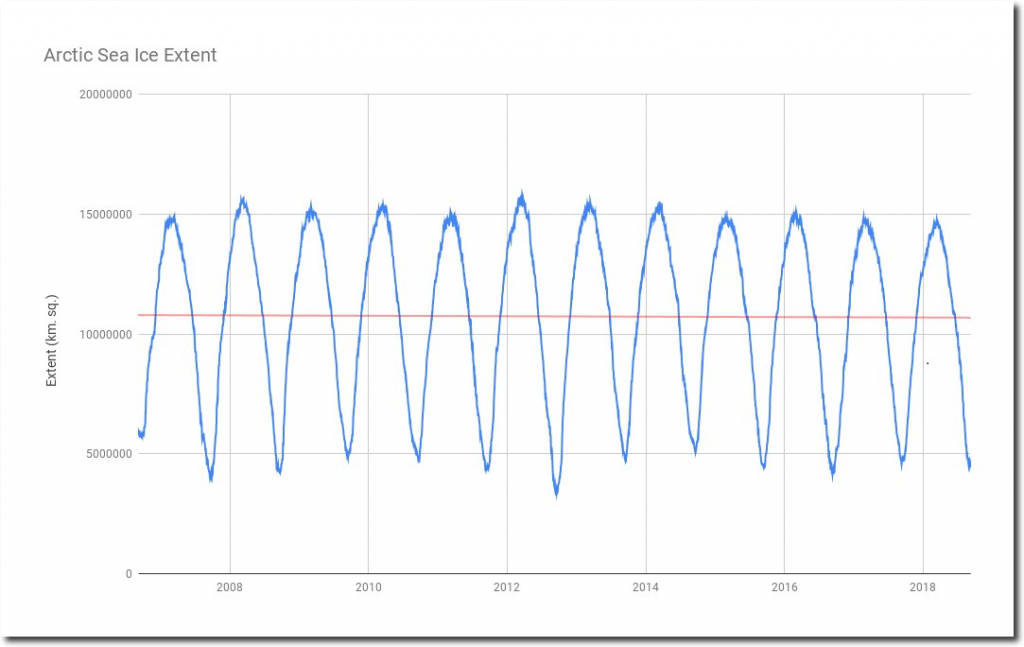
masie_4km_allyears_extent_sqkm.csv
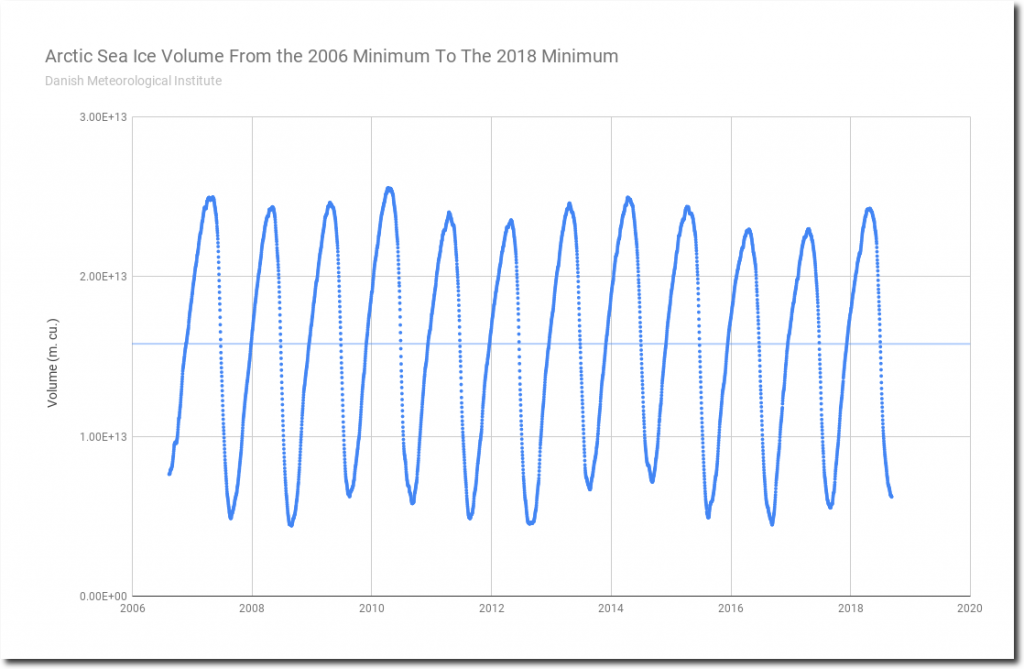
http://ocean.dmi.dk/arctic/icethickness/txt/IceVol.txt
Meanwhile, the New York Times says the “old ice is disappearing.”
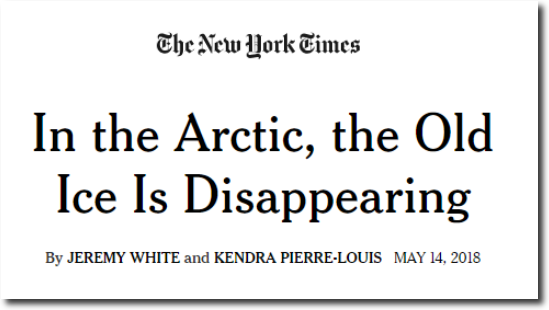
In the Arctic, the Old Ice Is Disappearing – The New York Times
This is impressive, because nine years ago experts said the old ice was effectively gone. Apparently it has gone lower than zero since then.
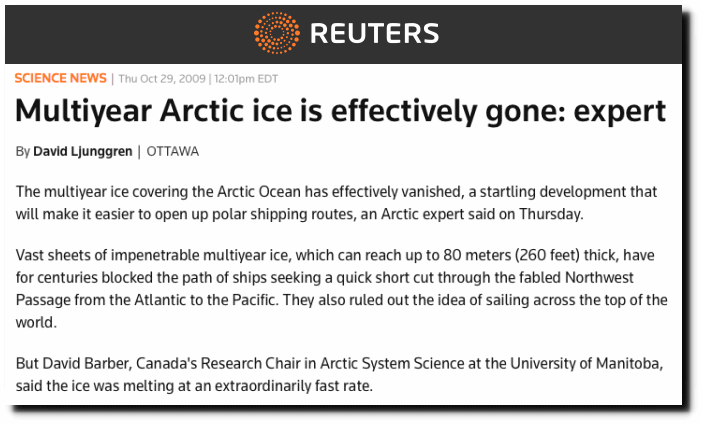
Multiyear Arctic ice is effectively gone: expert | Reuters
Almost all of the current ice has survived for one year, and is now multi-year ice........
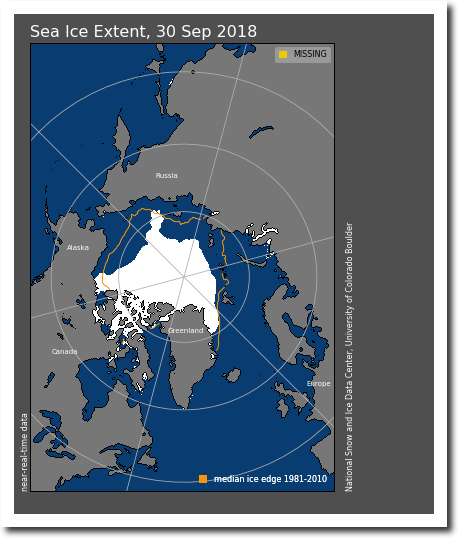
N_20180930_extn_v3.0.png (420×500)
There is nothing happening in the Arctic. The usual barrage of lies by climate scientists and the press is happening in climate controlled offices at much lower latitudes.”
……………………..
…….
Added: Communist China CO2 emissions lead the world, more than double US CO2: “Trends in Global CO2 Emissions, 2016 report,“ PBL Netherlands Environmental Assessment Agency European Commission, Joint Research Centre
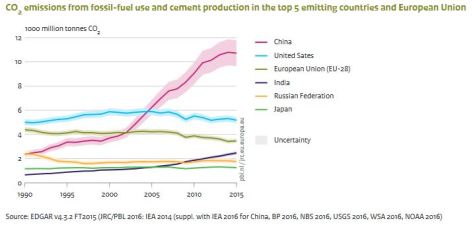
Above chart, pg. 14. Description on pg. 13:
“In summary, the six largest emitting countries/regions in 2015 were: China (with 29% share in the global total), the United States (14%), the European Union (EU-28) (10%), India (7%), the Russian Federation (5%) and Japan (3.5%) (Figure 2.2)”
........

Above chart, pg. 14. Description on pg. 13:
“In summary, the six largest emitting countries/regions in 2015 were: China (with 29% share in the global total), the United States (14%), the European Union (EU-28) (10%), India (7%), the Russian Federation (5%) and Japan (3.5%) (Figure 2.2)”
........
…………………………………..
Added: The “global climate science boom” was created entirely by global slaves, ie, US taxpayers. “Climate action” via US taxpayer dollars exploded in 1990, shown in chart below, mandated by George HW “New World Order” Bush and approved by the entire US political class.….Fall 2015, “Causes and Consequences of the Climate Science Boom," independent.org, Butos and McQuade (Chart below, page 4, pdf, is an underestimate, doesn’t include congressional appropriations):
Added: The “global climate science boom” was created entirely by global slaves, ie, US taxpayers. “Climate action” via US taxpayer dollars exploded in 1990, shown in chart below, mandated by George HW “New World Order” Bush and approved by the entire US political class.….Fall 2015, “Causes and Consequences of the Climate Science Boom," independent.org, Butos and McQuade (Chart below, page 4, pdf, is an underestimate, doesn’t include congressional appropriations):
…………….
“Note and Sources: The data shown here are funding disbursements by the White House U.S. Global Change Research Program and its predecessor, the National Climate Program, available at NCP 1988, 43; Climate Science Watch 2007; and Leggett, Lattanzio, and Bruner 2013. These data, however, do not represent congressional climate science funding appropriations to other government agencies. As we show later in a more detailed assessment of U.S. government climate science funding, the numbers here, especially those for more recent years, greatly underestimate the actual level of funding.” pdf p. 4
…………………………
Added: As of 2015, $4 billion per day is spent on imaginary CO2 terror which, even if it existed, is controlled by Communist China as chart above shows. This money could otherwise be spent on improving bridges, helping the poor, and addressing many environmental concerns currently being starved because they don't involve CO2:
Added: As of 2015, $4 billion per day is spent on imaginary CO2 terror which, even if it existed, is controlled by Communist China as chart above shows. This money could otherwise be spent on improving bridges, helping the poor, and addressing many environmental concerns currently being starved because they don't involve CO2:
…………
7/30/2015, “Is Climate Change Now Its Own Industry?" insurancejournalnews.com, Don Jergler
……
“Interest in climate change is becoming an increasingly powerful economic driver….Some see it as an industry in itself whose growth is driven in large part by policymaking [by the US political class which has unlimited access to US taxpayer dollars]. The $1.5 trillion global “climate change industry” [$4 billion per day]
grew at between 17 and 24 percent annually from 2005-2008, slowing to
between 4 and 6 percent following the recession with the exception of 2011’s inexplicable 15 percent growth, according to Climate Change Business Journal.
The San Diego, Calif.-based publication includes within that industry nine segments and 38 sub-segments. This encompasses sectors like renewables, green building and hybrid vehicles.
That also includes the climate change consulting market, which a recent report by the journal estimates at $1.9 billion worldwide and $890 million in the U.S.”…
……………………….
Added: “The recent standstill in global temperatures is a puzzle. Experts do not know why it is occurring or how long it will last….It is widely accepted that the main climate models which inform government policy did not predict it (which raises interesting issues of the models’ predictions about the future course of temperatures).…This is a vital policy issue since the strategy of this government and the previous Labour government to decarbonise the economy involves multi-billion pound spending decisions, paid for by consumers and taxpayers, which might not have been taken (at least to the same degree or with the same haste) if global warming was not quite the imminent threat it has been depicted.”
7/22/2013, “Andrew Neil on Ed Davey climate change interview critics," BBC, Andrew Neil
This was neatly summed up in a Guardian blog by Dana Nuccitelli, who works for a multi-billion dollar US environmental business (Tetra Tech) and writes prodigiously about global warming and related matters from a very distinct perspective.
He finished by saying: “[Andrew] Neil focussed only on the bits of evidence that seemed to support his position”.
This is partly right. We did come at Mr Davey with a particular set of evidence, which was well-sourced from mainstream climate science. But it was nothing to do with advocating a “position”.
First, the Sunday Politics does not have a position on any of the subjects on which it interrogates people. Second, it is the job of the interviewer to assemble evidence from authoritative sources which best challenge the position of the interviewee. There is hardly any purpose in presenting evidence which supports the interviewee’s position – that is his or her job.
It is for viewers to decide how well the interviewee’s position holds up under scrutiny and the strength of the contrary evidence or points put to him or her.
Reputable evidence
It is how the Sunday Politics approaches all the longer forensic interviews on the programme, no matter the subject or the interviewee. It is how it will approach any future interview with a leading light of the global warming sceptic camp. They can expect just as fair, forensic and robust an interview as Mr Davey.
Taking an opposite or challenging position from the person being interviewed is pretty much standard practice in long-form broadcast interviews.
But the contrary position has to be based on reputable evidence. The Guardian blog and other critics on Twitter alleged that the challenges put to Mr Davey were based on errors, false evidence or parroted the perspective of “deniers”. That is untrue.
The main purpose of the interview was to establish if the government thought the recent and continuing pause in global temperatures meant it should re-think its policies in response to global warming.
This is a vital policy issue since the strategy of this government and the previous Labour government to decarbonise the economy involves multi-billion pound spending decisions, paid for by consumers and taxpayers, which might not have been taken (at least to the same degree or with the same haste) if global warming was not quite the imminent threat it has been depicted.
It might also be argued that challenging interviews on matters in which there is an overwhelming consensus in Westminster – but not necessarily among voters who pay for both the licence fee and the government’s energy policies – is a particularly legitimate purpose of public-service broadcasting.
No consensus
The recent standstill in global temperatures is a puzzle. Experts do not know why it is occurring or how long it will last.
Climate scientists have proffered a variety of possible explanations. But there is no consensus.
Extensive peer-reviewed literature regards it as established yet unexplained. It is widely accepted that the main climate models which inform government policy did not predict it (which raises interesting issues of the models’ predictions about the future course of temperatures).
For many climate scientists the plateau – which may or may not have long-term significance – has come as something of a surprise.
Recently Nature, which has published extensively on global warming, called it one of climate science’s greatest mysteries. So it is legitimate to ask if the government takes the pause seriously and if it has any implications for policy ie, if there is a pause in warming, is there a case for the government to pause or slowdown its expensive efforts to decarbonise the economy until the picture becomes clearer?
The graph we presented illustrating the temperature plateau was not constructed by the Sunday Politics but taken from a website, produced by Phil Jones, a leading figure at the Climate Research Unit, University of East Anglia, which works closely with the UK Met Office and whose work, especially on temperature measurements, has done so much to inform government policy here and abroad. The basis of the graph can be found here.
The graph we presented on screen is pretty much identical to the post-1980 data in the graph created by the CRU. It is based on HadCRUT 3 data rather than HadCRUT 4, but the discrepancy between the two is small.
We made it clear on air that the graph had been “smoothed” – not by us but by the CRU – to iron out fluctuations and to highlight the trend.
This is legitimate for TV when viewers only have a view seconds to take in a visual. We used this graph in the belief that the CRU would not do the smoothing in a manner that distorted either the post-1980s rise or the post late-1990s plateau in temperatures.
Man-made heating
We chose 1980 as the start date for the graph because that is roughly when the IPCC says man-made warming became the dominant factor in global temperature rises.
The IPCC said in 2007: “The rapid warming observed since the 1970s has occurred in a period when the increase in greenhouse gases has dominated over all other factors.”
It said that, prior to then in the 20th century, any man-made heating was offset by other natural variations in the climate; but that human-released greenhouse gasses are the dominant explanation of the rise in temperatures post the 1970s.
Global temperatures between 1940-80 were broadly constant. They started rising in 1980; and especially here.
So it is reasonable to start the graph circa 1980 to show how temperatures rose thereafter – overwhelmingly as a result of greenhouse gasses, according to the IPCC--until the late 1990s; and then started to plateau, albeit at a high level compared with the rest of the 20th century.
Some have detected a slight decline in temperatures since circa 2004 but we did not dwell on that since it is statistically insignificant.
The 2007 IPCC study reported that the likely rise in equilibrium temperatures in response to a doubling of C02 in the atmosphere was between 2C and 4.5C, with 3C “most probable” (a slip of the tongue on air said 3%, but it was clear what was meant).
The plateau has made some climate scientists wonder about the efficacy of the IPCC central forecast, which has been seminal in informing official policy, and some are re-considering the IPCC’s measurement of climate sensitivity i.e. the extent to which temperatures rise in response to any given amount of C02 emissions.
There are reports in the media that the upcoming 2013 IPCC report might conclude that the climate is indeed more insensitive to emissions than previous concluded. We have no views on such matters, other than they are worthy of examination and debate – and have policy implications.
Mr Nuccitelli points out that temperatures have plateaued in the past, which is true. But since that was before, according to the IPCC, global warming became the dominant factor in temperature rises, it is not clear past plateaux are relevant to this debate; and the current hiatus is one of the longer ones.
It is also not clear from his blog if Mr Nuccitelli denies there is a plateau.
He has been a voluble exponent of a controversial “missing heat” theory that somehow the extra energy from global warming has started to bypass the atmosphere (hence the stalling in surface temperatures) and is storing up in the deep ocean; so perhaps he does accept the plateau.
Principle point
Mr Davey said in his interview- and others echoed the point later – that we should not concentrate just on land temperatures, but look at what was happening to ocean temperatures and the polar ice melt for evidence that global warming was continuing unabated.
This is a reasonable point. But in a 15-minute interview we wanted to stick with the metric that most viewers would understand and which has been used most to judge the course of global warming in public debate i.e. surface temperatures, which are central to the science and, for viewers, the principle point of interest.
At the Sunday Politics we are also used to public figures who try to change the metric when the one they’ve put their faith in does not behave as expected. We try not to let that happen.
Moreover, the purpose of the interview was not to question all aspects of climate science, just the one metric that has commanded most attention. Other possible indicators of climate change – ice melt, ocean temperatures and extreme weather events – are a matter of widespread debate in which the science most certainly is not “settled”.
For example, trends in Arctic ice decline and ocean warming are not necessarily irrefutable evidence of continued global warming, though many climate scientists believe they are indeed caused by global warming.
Others point out that satellite observations began in 1979 and caught a decline in Arctic ice already in progress. So the origin of the decline could be many decades ago, and might not have been started by man (though global warming could now be exacerbating a previous “natural” melting trend).
There is evidence of great variability in sea ice in the Arctic from historical records and old newspaper cuttings from decades ago reporting the disappearance of the ice.
A new paper by the Danish Meteorological Institute (DMI) suggest that Greenland ice sheet melting is related to solar activity and “a considerable fraction of the current withdrawal could be a natural occurrence”.
These are fascinating and contested matters and could easily be pursued in future interviews. The Sunday Politics has no views on their efficacy; but they are issues worthy of investigation and interrogation.
The question in the interview which stated that the Arctic ice melt this year is “normal” should have been qualified: it is normal in the sense of the much greater normal summer ice melt of recent years i.e. it has not got worse – but even that cannot be said for sure until September when the ice melt reaches its greatest extent.
This illustrates that we cannot do justice to the canon of global warming in 15 minutes – and justifies the decision to stick to one well-known and crucial metric.
It is not true to say – though it was said by Mr Davey and subsequently – that we ignored ocean temperatures altogether. The HadCRUT data measures surface temperatures across the globe, including ocean surface temperatures.
There is a huge debate in climate science over the relationship between global warming and ocean temperatures. As pointed out above some scientists (and Mr Nuccitelli) believe that global warming is causing the depths of the oceans to heat up and that one day this heat will be released.
This is widely contested and even, by some, dismissed. The data is short-lived and contentious (the “warming” at depths of many hundreds of metres is being measured in hundredths of a degree C). We did not have time to go there in the interview.
We stuck to the advice of Professor Judith Curry, chair of the School of Earth and Atmospheric Sciences at the Georgia Institute of Technology and a world authority on global warming, that: “… the best (most mature, highest quality) data set for inferring recent climate change is the surface temperature data record.”
Mr Nuccitelli is also one of the authors of the recent study of climate science abstracts which concludes that 97% of climate scientists are part of the global warming consensus.
This survey has been quoted several times by Mr Davey in interviews to assert that the science is “settled”; he did so again in our interview. It was reasonable to point out that the methodology and conclusions of the survey have been fiercely challenged by Prof Richard Tol, a respected academic quoted extensively in the Stern Report. Other academics have their misgivings.
There is now an argument underway between critics and authors about how much raw data they are prepared to make available for examination; and that neither the academic publication which carried it nor the Guardian will give Professor Tol a right of reply.
These are matters for academia. We simply wanted to point out, when Mr Davey called it in aid, that the survey, especially given the strongly partisan positions of the authors, is not uncontested.
More important, the survey’s definition of “global warming consensus” is so wide as to include most who are regarded as sceptics, most of whom agree that global warming is happening and that there is a man-made contribution.
The survey was recently attacked in testimony to the US Congress by Dr Roy Spencer, Principal Research Scientist at the University of Alabama Hunstville, which carries out world-renowned and heavily-relied upon satellite measurements of global temperatures.
He told Congress the definition of consensus in the survey was so widely drawn as to be “innocuous” and would include him within the consensus even though he is often depicted by people like Mr Nuccitelli as being on the sceptical wing of climate science.
Unfounded claims
The differences that separate climate scientists even within the “consensus” are over the speed and extent of warming, the consequences (economic and environmental) and the importance of other climate factors which are not man-made and which may affect the climate’s sensitivity to the rise in C02 emissions.
Only those who have been dismissed as “deniers” deny that man is playing any role whatsoever, though the word is often applied to sceptics too (and even, ridiculously, to the Sunday Politics!).
Contrary to many unfounded claims on Twitter, the research work behind our interview and the evidence it gathered was not influenced by any deniers. We relied on Nature magazine, the work of the Climate Research Unit, Professor Judith Curry of Georgia Tech and Professor Hans von Storch of Hamburg University among others, all of whom think man-made global warming is real and some of whom have been at the very heart of the climate science community. We quoted no deniers or even sceptics. All our evidence came from mainstream scientists who do not doubt the fundamental tenets of global warming.
Professor Tol is a climate economist. He has strong views on the economic impact of climate change. But we are not aware he denies it is happening.
At no stage in the interview was it ever claimed that global warming is not real or that it is not man-made. It is not for the Sunday Politics to take such positions.
Our focus was on a global temperature plateau which could be a challenge to the forecasts of climate models which have determined government policy. The plateau could continue for the foreseeable future or melt away as temperatures resume their upward trajectory.
The Sunday Politics has no views on such matters. We have put the existence of this plateau into the broader public domain. It is for others to determine its significance.”
…………………………….The San Diego, Calif.-based publication includes within that industry nine segments and 38 sub-segments. This encompasses sectors like renewables, green building and hybrid vehicles.
That also includes the climate change consulting market, which a recent report by the journal estimates at $1.9 billion worldwide and $890 million in the U.S.”…
……………………….
Added: “The recent standstill in global temperatures is a puzzle. Experts do not know why it is occurring or how long it will last….It is widely accepted that the main climate models which inform government policy did not predict it (which raises interesting issues of the models’ predictions about the future course of temperatures).…This is a vital policy issue since the strategy of this government and the previous Labour government to decarbonise the economy involves multi-billion pound spending decisions, paid for by consumers and taxpayers, which might not have been taken (at least to the same degree or with the same haste) if global warming was not quite the imminent threat it has been depicted.”
7/22/2013, “Andrew Neil on Ed Davey climate change interview critics," BBC, Andrew Neil
“The Sunday Politics interview with Energy and Climate Change Secretary Ed Davey on July 14 [2013]
provoked widespread reaction in the twittersphere and elsewhere, which
was only to be expected given the interview was about the latest developments in global warming and the implications for government policy [ie, free taxpayer cash].
The Sunday Politics remit and interview duration means we are able to carry out proper forensic interviews on such matters….Many of the criticisms of the Davey interview seem to misunderstand the purpose of a Sunday Politics interview.
The Sunday Politics remit and interview duration means we are able to carry out proper forensic interviews on such matters….Many of the criticisms of the Davey interview seem to misunderstand the purpose of a Sunday Politics interview.
This was neatly summed up in a Guardian blog by Dana Nuccitelli, who works for a multi-billion dollar US environmental business (Tetra Tech) and writes prodigiously about global warming and related matters from a very distinct perspective.
He finished by saying: “[Andrew] Neil focussed only on the bits of evidence that seemed to support his position”.
This is partly right. We did come at Mr Davey with a particular set of evidence, which was well-sourced from mainstream climate science. But it was nothing to do with advocating a “position”.
First, the Sunday Politics does not have a position on any of the subjects on which it interrogates people. Second, it is the job of the interviewer to assemble evidence from authoritative sources which best challenge the position of the interviewee. There is hardly any purpose in presenting evidence which supports the interviewee’s position – that is his or her job.
It is for viewers to decide how well the interviewee’s position holds up under scrutiny and the strength of the contrary evidence or points put to him or her.
Reputable evidence
It is how the Sunday Politics approaches all the longer forensic interviews on the programme, no matter the subject or the interviewee. It is how it will approach any future interview with a leading light of the global warming sceptic camp. They can expect just as fair, forensic and robust an interview as Mr Davey.
Taking an opposite or challenging position from the person being interviewed is pretty much standard practice in long-form broadcast interviews.
But the contrary position has to be based on reputable evidence. The Guardian blog and other critics on Twitter alleged that the challenges put to Mr Davey were based on errors, false evidence or parroted the perspective of “deniers”. That is untrue.
The main purpose of the interview was to establish if the government thought the recent and continuing pause in global temperatures meant it should re-think its policies in response to global warming.
This is a vital policy issue since the strategy of this government and the previous Labour government to decarbonise the economy involves multi-billion pound spending decisions, paid for by consumers and taxpayers, which might not have been taken (at least to the same degree or with the same haste) if global warming was not quite the imminent threat it has been depicted.
It might also be argued that challenging interviews on matters in which there is an overwhelming consensus in Westminster – but not necessarily among voters who pay for both the licence fee and the government’s energy policies – is a particularly legitimate purpose of public-service broadcasting.
No consensus
The recent standstill in global temperatures is a puzzle. Experts do not know why it is occurring or how long it will last.
Climate scientists have proffered a variety of possible explanations. But there is no consensus.
Extensive peer-reviewed literature regards it as established yet unexplained. It is widely accepted that the main climate models which inform government policy did not predict it (which raises interesting issues of the models’ predictions about the future course of temperatures).
For many climate scientists the plateau – which may or may not have long-term significance – has come as something of a surprise.
Recently Nature, which has published extensively on global warming, called it one of climate science’s greatest mysteries. So it is legitimate to ask if the government takes the pause seriously and if it has any implications for policy ie, if there is a pause in warming, is there a case for the government to pause or slowdown its expensive efforts to decarbonise the economy until the picture becomes clearer?
The graph we presented illustrating the temperature plateau was not constructed by the Sunday Politics but taken from a website, produced by Phil Jones, a leading figure at the Climate Research Unit, University of East Anglia, which works closely with the UK Met Office and whose work, especially on temperature measurements, has done so much to inform government policy here and abroad. The basis of the graph can be found here.
The graph we presented on screen is pretty much identical to the post-1980 data in the graph created by the CRU. It is based on HadCRUT 3 data rather than HadCRUT 4, but the discrepancy between the two is small.
We made it clear on air that the graph had been “smoothed” – not by us but by the CRU – to iron out fluctuations and to highlight the trend.
This is legitimate for TV when viewers only have a view seconds to take in a visual. We used this graph in the belief that the CRU would not do the smoothing in a manner that distorted either the post-1980s rise or the post late-1990s plateau in temperatures.
Man-made heating
We chose 1980 as the start date for the graph because that is roughly when the IPCC says man-made warming became the dominant factor in global temperature rises.
The IPCC said in 2007: “The rapid warming observed since the 1970s has occurred in a period when the increase in greenhouse gases has dominated over all other factors.”
It said that, prior to then in the 20th century, any man-made heating was offset by other natural variations in the climate; but that human-released greenhouse gasses are the dominant explanation of the rise in temperatures post the 1970s.
Global temperatures between 1940-80 were broadly constant. They started rising in 1980; and especially here.
So it is reasonable to start the graph circa 1980 to show how temperatures rose thereafter – overwhelmingly as a result of greenhouse gasses, according to the IPCC--until the late 1990s; and then started to plateau, albeit at a high level compared with the rest of the 20th century.
Some have detected a slight decline in temperatures since circa 2004 but we did not dwell on that since it is statistically insignificant.
The 2007 IPCC study reported that the likely rise in equilibrium temperatures in response to a doubling of C02 in the atmosphere was between 2C and 4.5C, with 3C “most probable” (a slip of the tongue on air said 3%, but it was clear what was meant).
The plateau has made some climate scientists wonder about the efficacy of the IPCC central forecast, which has been seminal in informing official policy, and some are re-considering the IPCC’s measurement of climate sensitivity i.e. the extent to which temperatures rise in response to any given amount of C02 emissions.
There are reports in the media that the upcoming 2013 IPCC report might conclude that the climate is indeed more insensitive to emissions than previous concluded. We have no views on such matters, other than they are worthy of examination and debate – and have policy implications.
Mr Nuccitelli points out that temperatures have plateaued in the past, which is true. But since that was before, according to the IPCC, global warming became the dominant factor in temperature rises, it is not clear past plateaux are relevant to this debate; and the current hiatus is one of the longer ones.
It is also not clear from his blog if Mr Nuccitelli denies there is a plateau.
He has been a voluble exponent of a controversial “missing heat” theory that somehow the extra energy from global warming has started to bypass the atmosphere (hence the stalling in surface temperatures) and is storing up in the deep ocean; so perhaps he does accept the plateau.
Principle point
Mr Davey said in his interview- and others echoed the point later – that we should not concentrate just on land temperatures, but look at what was happening to ocean temperatures and the polar ice melt for evidence that global warming was continuing unabated.
This is a reasonable point. But in a 15-minute interview we wanted to stick with the metric that most viewers would understand and which has been used most to judge the course of global warming in public debate i.e. surface temperatures, which are central to the science and, for viewers, the principle point of interest.
At the Sunday Politics we are also used to public figures who try to change the metric when the one they’ve put their faith in does not behave as expected. We try not to let that happen.
Moreover, the purpose of the interview was not to question all aspects of climate science, just the one metric that has commanded most attention. Other possible indicators of climate change – ice melt, ocean temperatures and extreme weather events – are a matter of widespread debate in which the science most certainly is not “settled”.
For example, trends in Arctic ice decline and ocean warming are not necessarily irrefutable evidence of continued global warming, though many climate scientists believe they are indeed caused by global warming.
Others point out that satellite observations began in 1979 and caught a decline in Arctic ice already in progress. So the origin of the decline could be many decades ago, and might not have been started by man (though global warming could now be exacerbating a previous “natural” melting trend).
There is evidence of great variability in sea ice in the Arctic from historical records and old newspaper cuttings from decades ago reporting the disappearance of the ice.
A new paper by the Danish Meteorological Institute (DMI) suggest that Greenland ice sheet melting is related to solar activity and “a considerable fraction of the current withdrawal could be a natural occurrence”.
These are fascinating and contested matters and could easily be pursued in future interviews. The Sunday Politics has no views on their efficacy; but they are issues worthy of investigation and interrogation.
The question in the interview which stated that the Arctic ice melt this year is “normal” should have been qualified: it is normal in the sense of the much greater normal summer ice melt of recent years i.e. it has not got worse – but even that cannot be said for sure until September when the ice melt reaches its greatest extent.
This illustrates that we cannot do justice to the canon of global warming in 15 minutes – and justifies the decision to stick to one well-known and crucial metric.
It is not true to say – though it was said by Mr Davey and subsequently – that we ignored ocean temperatures altogether. The HadCRUT data measures surface temperatures across the globe, including ocean surface temperatures.
There is a huge debate in climate science over the relationship between global warming and ocean temperatures. As pointed out above some scientists (and Mr Nuccitelli) believe that global warming is causing the depths of the oceans to heat up and that one day this heat will be released.
This is widely contested and even, by some, dismissed. The data is short-lived and contentious (the “warming” at depths of many hundreds of metres is being measured in hundredths of a degree C). We did not have time to go there in the interview.
We stuck to the advice of Professor Judith Curry, chair of the School of Earth and Atmospheric Sciences at the Georgia Institute of Technology and a world authority on global warming, that: “… the best (most mature, highest quality) data set for inferring recent climate change is the surface temperature data record.”
Mr Nuccitelli is also one of the authors of the recent study of climate science abstracts which concludes that 97% of climate scientists are part of the global warming consensus.
This survey has been quoted several times by Mr Davey in interviews to assert that the science is “settled”; he did so again in our interview. It was reasonable to point out that the methodology and conclusions of the survey have been fiercely challenged by Prof Richard Tol, a respected academic quoted extensively in the Stern Report. Other academics have their misgivings.
There is now an argument underway between critics and authors about how much raw data they are prepared to make available for examination; and that neither the academic publication which carried it nor the Guardian will give Professor Tol a right of reply.
These are matters for academia. We simply wanted to point out, when Mr Davey called it in aid, that the survey, especially given the strongly partisan positions of the authors, is not uncontested.
More important, the survey’s definition of “global warming consensus” is so wide as to include most who are regarded as sceptics, most of whom agree that global warming is happening and that there is a man-made contribution.
The survey was recently attacked in testimony to the US Congress by Dr Roy Spencer, Principal Research Scientist at the University of Alabama Hunstville, which carries out world-renowned and heavily-relied upon satellite measurements of global temperatures.
He told Congress the definition of consensus in the survey was so widely drawn as to be “innocuous” and would include him within the consensus even though he is often depicted by people like Mr Nuccitelli as being on the sceptical wing of climate science.
Unfounded claims
The differences that separate climate scientists even within the “consensus” are over the speed and extent of warming, the consequences (economic and environmental) and the importance of other climate factors which are not man-made and which may affect the climate’s sensitivity to the rise in C02 emissions.
Only those who have been dismissed as “deniers” deny that man is playing any role whatsoever, though the word is often applied to sceptics too (and even, ridiculously, to the Sunday Politics!).
Contrary to many unfounded claims on Twitter, the research work behind our interview and the evidence it gathered was not influenced by any deniers. We relied on Nature magazine, the work of the Climate Research Unit, Professor Judith Curry of Georgia Tech and Professor Hans von Storch of Hamburg University among others, all of whom think man-made global warming is real and some of whom have been at the very heart of the climate science community. We quoted no deniers or even sceptics. All our evidence came from mainstream scientists who do not doubt the fundamental tenets of global warming.
Professor Tol is a climate economist. He has strong views on the economic impact of climate change. But we are not aware he denies it is happening.
At no stage in the interview was it ever claimed that global warming is not real or that it is not man-made. It is not for the Sunday Politics to take such positions.
Our focus was on a global temperature plateau which could be a challenge to the forecasts of climate models which have determined government policy. The plateau could continue for the foreseeable future or melt away as temperatures resume their upward trajectory.
The Sunday Politics has no views on such matters. We have put the existence of this plateau into the broader public domain. It is for others to determine its significance.”
...................
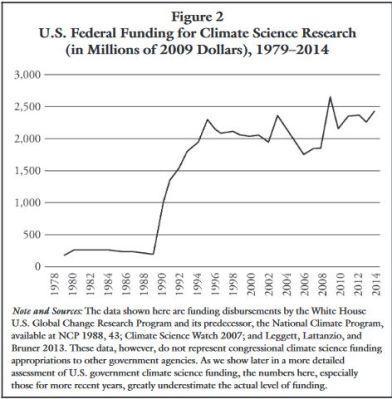

No comments:
Post a Comment